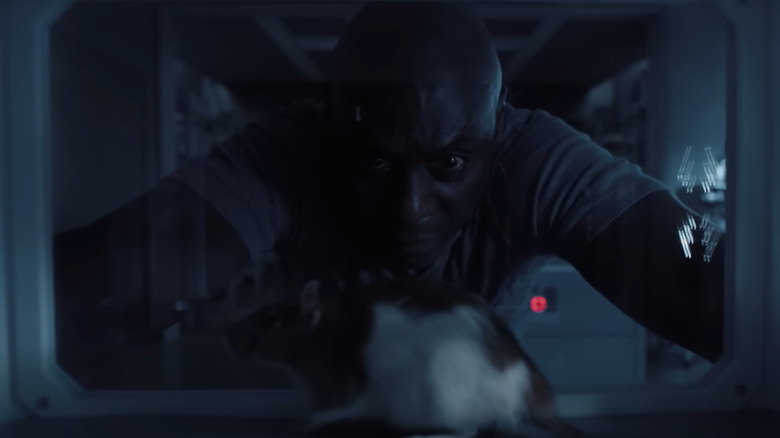Resident Evil Lore You Should Know Before Watching The Netflix Series
"Resident Evil" has remained a horror pop culture mainstay since the original game's debut back in 1996. The global phenomenon boasts 28 games, seven live-action feature films, six audio dramas, five CGI animated films with canonical game storytelling, four stage productions including a musical, four different in-universe documentaries, an animated series, a live-action series adaptation from Netflix, and a partridge in a pear tree. "Resident Evil" has been revived, rebooted, and refreshed so many times it's now become impossible to successfully adapt the material in a way that would appeal to all fans of the franchise. Keeping up with the litany of storylines and years of lore can be difficult, but with the Netflix series heading soon to streaming devices, it felt necessary to provide a quick refresher on what audiences can possibly expect.
As the "Resident Evil" storylines cross a variety of mediums, it's important to remember that information provided in the films may not be in line with what was provided with the games. Sorry, Alice fans, but there will be no mention of Milla Jovovich's character from the Paul W.S. Anderson films here. Based on the trailer, it's clear that the new series is going to branch off of a few existing elements from the games, so consider this your guide to what you should know before watching the new "Resident Evil" series on Netflix.
The T-Virus
Just about everything that happens in the vast and horrific world of "Resident Evil" can all be traced back to one devastating creation: the Tyrant Virus, more commonly known as the T-Virus. Discovered in 1966, Dr. Oswell E. Spencer and his colleagues Dr. Edward Ashford and Dr. James Marcus intended to use the Progenitor strain to usher in a new era of eugenics, by using mutagenic viruses as a means to eliminate biological "shortcomings" in the human race, capitalizing off ableism. To fund the research, Umbrella Pharmaceuticals was born. Known as "The Wesker Project," the research of the virus took multiple forms. The T-Virus is a series of independently developed strains and not a single virus, so developing new strains did not necessarily require recent research by other teams.
In the instance of one strand, the T-Virus was used to eliminate the need for a conventional army by creating a highly contagious bio weapon that would guarantee a 100% mortality rate. Understandably, the mutant strain was impossible to execute as people would become infected and continue spreading the virus before it had a chance to kill off the intended targets. By the late 1970s, the direction of execution pivoted toward modifying the T-Virus to something that could manipulate the genes of a host to become physically stronger, faster, and stay alive regardless of organ failure or damage. Unfortunately, this led to the hosts developing insatiable hunger and uncontrollable aggression, effectively turning hosts into zombies.
The T-Virus: Phase 2 and 3
Umbrella Corporation was unwilling to give up on their research, and after it was discovered in the early 1980s that roughly 10% of the population was naturally immune or an unmutated asymptomatic carrier of the virus, they turned to Phase 2. Phase 2 involved the Umbrella Corp developing workarounds for the virus, but Dr. William Birkin of the Arklay Laboratory team was simultaneously developing new species of animals like the "Web Spinner" spiders and the human-animal hybrid "Hunters," which would take out humans in their path. Birkin used stolen samples and research data to develop creatures that would eliminate the 10% surviving populations. The T-Virus was mass-produced within Umbrella and supplied to the research facilities to develop reliable, intelligent B.O.W.s, or Bio Organic Weapons.
This marked the start of Phase 3, and with it brought additional mutations like Crimson Heads and Lickers, in addition to the Tyrant Project, the Nemesis Project, and other viral strains. This included the T+G-Virus, which allowed bodies to discharge electricity; T-Phobos, which would trigger mutations when the host produced stress hormones due to fear; and T-Veronica, which under the best conditions allows the host to retain full intellectual capabilities. In all "Resident Evil" adaptations, including the new Netflix series, the uncontrolled spread of the T-Virus is what gives birth to a world of monsters and mayhem.
Albert Wesker
Lance Reddick stars in the new Netflix series as series' mainstay Dr. Albert Wesker. While the new "Resident Evil" series looks to be straying away from the video game's original source material, the story of Albert Wesker is fascinating, and it'll be interesting to see how much is kept as part of the new story. Per the game's lore, Dr. Albert Wesker was once an accomplished virologist, notorious for his elite perfectionism. Wesker was vital in shaping the Umbrella Corporation's B.O.W. research, but later left the company to pursue work as a spy, eventually collaborating with the United States Army and later becoming a Special Tactics and Rescue Service (S.T.A.R.S.) Captain.
In 1998, a new strain infected a number of staff at the Arklay Laboratory in Raccoon City, forcing a quarantine with an order to kill any employees who escaped. Wesker joined Dr. Birkin to save and evacuate cloned t-002 Tyrant embryos, one of the most important and dangerous creations in Umbrella's history. Sadly, the infection got out of the lab's confines and began infecting Raccoon City. With a full-on execution planned, Wesker was given orders to save the remaining embryos and to sacrifice S.T.A.R.S. to the mutants as a means to provide combat data and wipe them out as witnesses. Wesker betrayed S.T.A.R.S. by sabotaging the Bravo Team's escape helicopter, preventing them from escaping and forcing the Alpha Team to investigate.
The legacy of Albert Wesker
Throughout the course of the "Resident Evil" games, it's shown time and time again that Wesker's obsession with the various strains of the T-Virus is ravenous. He releases the Tyrant at Spencer Mansion, serves as a T-Virus pin cushion for numerous strains, and does it all with a flair for the camp dramatics. What started out as a quest for power quickly turned into an otherworldly desire, viewing himself as a "chosen one" to bring on the mass extinction of humanity. The new Netflix series shows Wesker as having adopted two daughters, Billie and Jade, which is not part of the video game or any of the film adaptation's continuity. However, in the game "Resident Evil 6," it is discovered that Wesker fathered a son, Jake Muller.
An anti-heroic mercenary raised in Eastern Europe, Jake Muller was brought into a conspiracy to instigate major terrorist attacks with the C-Virus, a family of viruses with a genome containing genes from the T-Veronica and Golgotha Virus considered to be the "next generation" of bioweaponry. Muller has never been seen as a character in any of the live-action adaptations of "Resident Evil," and with the new Netflix series focusing partially on a future long after the T-Virus has ravaged the globe, the introduction of Jake Muller would be particularly fascinating. Billie and Jade are said to be spending the series discovering the secrets of their father, and what could be more interesting than discovering they've had a brother this whole time?
All eight episodes of "Resident Evil" will premiere July 14, 2022 on Netflix.




